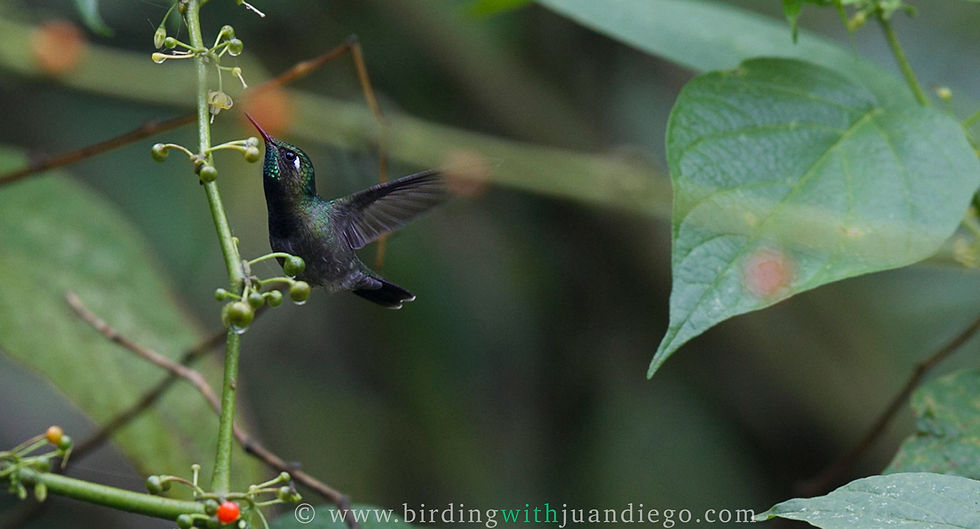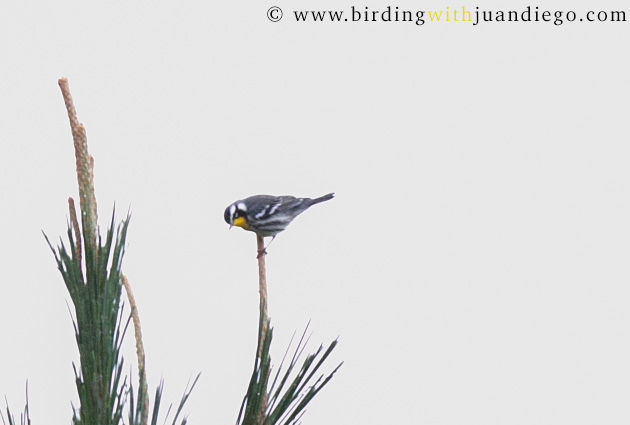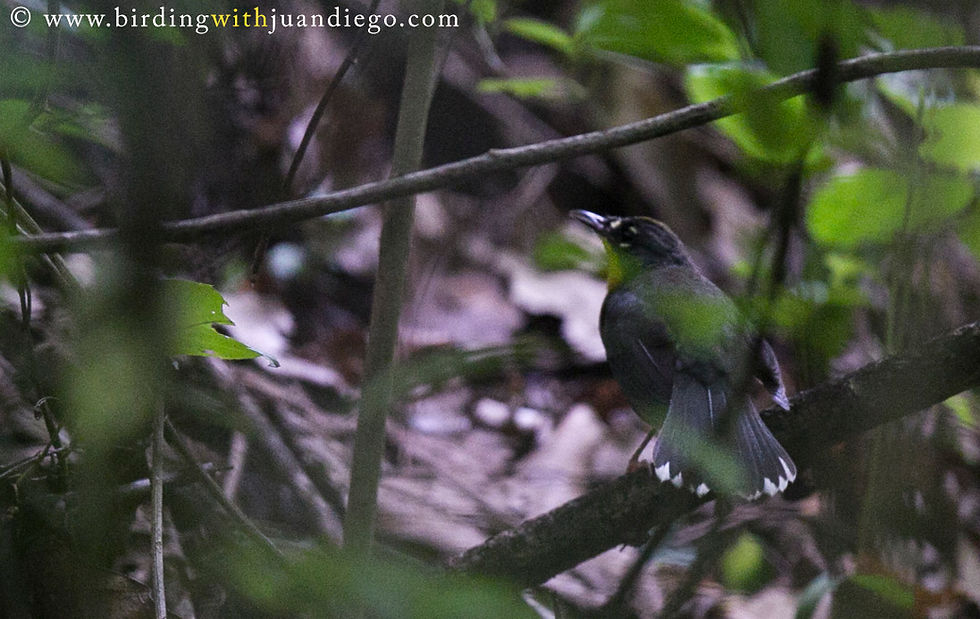Off the beaten path... Exploring Northern Nicaragua as part of my Central America Big Year.
- Juan Diego Vargas
- 16 ago 2017
- 8 Min. de lectura
As some of you know this year one of my main "birding" goals is to set a personal record for most birds seen in Central America. As I lead tours in the central america countries I thought I wont be so difficult but as the year goes I realized there are some birds you simply don't get in the average birding hotspots where I guide some of my customers so I have to move "off the beaten path" to find some of the hardest Central America birds. This time was the case of Northen Nicaragua.
Nicaragua is not usually mentioned with much frequency. It does not have any endemics, its infrastructure is not as well developed as other Central American countries and the recent political inclination is not the best propaganda for the country. Despite these minor details this country offers fantastic opportunities for birding with its great diversity of habitats. Coming from Costa Rica, one of the more attractive aspects of Nicaragua is the presence of pine forests and the birds that inhabit them. Pines only made it as far south as northern Nicaragua, thus directly influencing the distribution of many species of birds which do not go any further south. Likewise many species of birds that inhabit the highlands of northern Central America do not cross the lowland gap created by the Nicaraguan Depression.
I did this trip with my friend and fellow Big Year partner, Ernesto. Our trip to Nicaragua was very brief so we focused our efforts just north of Jinotega, at Reserva El Jaguar and the surrounding areas and worked hard on our list of posible targets. All in all we did very well, seeing most of the posible new year birds, though there were a couple species that we expected, but did not find. To make up for it though, we also found a couple species that we were not expecting!
Even if I only saw 9 year birds and of those 4 were lifers the birding in general was spectacular and the understanding of the tropical central american birds increase considerably as I spent some time observing and thinking on the many reasons that produce the uncommon bird composition of this ecosystems. The presence of a flock of early migrants in the pines was exciting and brought one of the best finds of the trip, a juvenile female Golden-cheeked Warbler. This sighting may represent the earliest record for Central America according to the available information in the eBird database.
Below you will find a list of my top 50 most interesting birds I found in this scouting.
1- Slaty-breasted Tinamou
Reserva El Jaguar
Although a 'heard only" it is interesting to hear this and the following species in the same spot. It is cloud forest, but both overlap here.
2- Thicket Tinamou
Reserva El Jaguar
Although a 'heard only" it is interesting to hear this and the previous species in the same spot. It is cloud forest, but both overlap here.
3- Highland Guan
Reserva El Jaguar
Maybe the best place in the whole range of this species to see and take photographs as they come every morning to eat corn that the workers use to feed the farm chickens.

4- Crested Bobwhite
Pinares San Rafael del Norte
5- Sharp-shinned Hawk
Hills South of Jinotega, Nicaragua
Definitely this is one of the resident subspecies that were considered by some authors a full taxon, White-breasted Hawk. Unfortunately, as of now it is just another Sharp-shinned Hawk for eBird. Although this one was a year bird for Ernesto.
6- Red-tailed Hawk
Pinares San Rafael del Norte
Although a heard only we were curious to see this bird to make sure is the same "costaricensis" subspecies. We couldn't located the calling bird.
7- Ruddy Crake (LIFER!)
Reserva El Jaguar
This is one of the most interesting sightings of the trip as we both were looking forward to finding this bird and actually see it to try to get some field experience and tips to tell apart Ruddy Crake from White-throated Crake as both overlap (apparently) in much of the southern part of Nicaragua and the northern part of Costa Rica. After many years of no visual reports it has become a real rarity in Costa Rica. So last year when Juan Diego was exploring El Jaguar for the first time he heard Ruddy Crakes in a small pond and this trip was willing to dip in and explore the bird habitat and hopefully get some views. Luckily for us, as soon as we started walking the edge of the lagoon two Ruddy Crakes flew right in front of us from a nest with recently hatched young birds. The young birds were making calls in the dense vegetation and the two adults were calling back from the opposite side of the lagoon trying to call the babies away from the "predators with binoculars and cameras". We got a few record shots and also measurements and photos of the nest.
For other birders looking for this bird "as a rarity" in Costa Rica here are three quick tips:
- Try a lagoon white dense grass adjacent to forest (that was the habitat)
- The call might sound very similar, but sometimes sound kind of slower than the one of White-throated Crake, and the strong "churp" call note is diagnostic.
- The northern volcanos of Costa Rica seem like the best area for it. It behaves the same as a White-throated, but is clearly all ruddy with no white throat and just a very evident gray helmet.

8- Plain-breasted Ground-Dove
Hills South of Jinotega, Nicaragua
9- White-faced Quail-Dove
Reserva El Jaguar
Year bird for both of us, although we could not get a photo of it we kept hearing the bird in several sites of the farm.
10- Lesser Ground-Cuckoo
Hills South of Jinotega, Nicaragua
One bird we targeted for this trip was the Lesser Roadrunner and we were pretty sure we would get it as Juan Diego saw it during his last trip to Nicaragua last year in the Pine-Oak forests near El Jaguar. Although we tried and tried we were unsuccessful in our attempts. The last day we were driving back with our local Nica driver, he stopped the car saying the bird we were looking for is what they call "Alma de Perro" (something like Dog Soul) and it was very common at this particular spot. We literally ran down a hill because he heard one just to find that it was actually a Lesser Ground-Cuckoo... pretty similar bird when you think about behavior and movement and they apparently both share habitat, so for the non-birder eye they can pretty much be the same thing. The positive side of this is that we learned a very cool local name for the Ground-Cuckoo: "Dog Soul".
11- Great Swallow-tailed Swift (LIFER!)
Hills South of Jinotega, Nicaragua
Nice to find this amazing swift overflying the Pine-Oak forest. In much thanks that Ernesto heard a suspicious Swift flying over our heads and ran out to find it. It was a small flock and we were unable to get decent photos, but we had clear views and we heard them calling two or more times.
12- Green-breasted Mountain-gem
Reserva El Jaguar
A very regular and almost guaranteed endemic in the porterweed flowers around the coffee farm.

13- Sparkling-tailed Hummingbird
Pinares San Rafael del Norte
14- Emerald-chinned Hummingbird
Reserva El Jaguar
Although normally easy and reliable around the restaurant of El Jaguar this time this cool endemic gave us some work and it was not until we waited at a local Tomatillo bush (Solanacea, a species of nightshade) for over 45 minutes (thanks to the suggestions of our great local guide Wilmer Talavera). Although it is in its own monotypic genus, we couldn't help noticing how similar it is to Violet-headed Hummingbird!

15- Stripe-tailed Hummingbird
Reserva El Jaguar
16- Azure-crowned Hummingbird
Pinares San Rafael del Norte
Definitely one of the showier Amazilia hummingbirds!
17- White-eared Hummingbird
Pinares San Rafael del Norte
18- Turquoise-browed Motmot
Hills South of Jinotega, Nicaragua
19- Emerald Toucanet
Reserva El Jaguar
A nice subspecies, Aulacorhynchus prasinus virescens with completely white throat. Very interesting to see and a real beauty for us that are more familiar with the blue-throated subspecies "maxillaris" of Costa Rica and Panama.
20- Acorn Woodpecker
Pinares San Rafael del Norte
Nice to see the amazing graneries of this woodpecker in the pine-oak forest. This is an interesting behavior you don't see in all the populations of this species in Central America.

21- Smoky-brown Woodpecker
Reserva El Jaguar
22- Golden-olive Woodpecker
Reserva El Jaguar
23- Northern Flicker
Pinares San Rafael del Norte
24- American Kestrel
Pinares San Rafael del Norte
25- Crimson-fronted Parakeet
Reserva El Jaguar
26- Strong-billed Woodcreeper
Reserva El Jaguar
A very different subspecies in head pattern and color than the much more easy one in Ecuador and South America. Still not as difficult as the one found in Costa Rica and Panama, though!

27- Greater Pewee
Pinares San Rafael del Norte

28- Sulphur-bellied Flycatcher
Pinares San Rafael del Norte
29- Rufous-browed Peppershrike
Pinares San Rafael del Norte
A widespread species, but a favorite of many, this massive member of the vireo family has a powerful bill and uses it to rip open curled leaves to pull out the invertebrates hiding inside. If anyone has held this bird in the hand you know how painful it can be!
30- Plumbeous Vireo
Pinares San Rafael del Norte
This vireo had us excited because we saw a recently fledged individual and the literature we had did not mention anything about its breeding status in Nicaragua. Speaking with Georges Duriaux of El Jaguar, he mentioned it wasn't until recently they had confirmed it as a breeding bird of the local pine forests.
31- White-throated Magpie-Jay
Pinares San Rafael del Norte
32- Bushy-crested Jay
Reserva El Jaguar
This attractive jay was fairly common in most habitats, everything from the shade-grown coffee farms of El Jaguar to the pine-oak forests of San Rafael. As with many jays, juveniles have differently colored bills, usually yellow. Most of the family groups we encountered were feeding young birds.
33- Band-backed Wren
Reserva El Jaguar
34- Cabanis's Wren
Reserva El Jaguar
35- White-breasted Wood-Wren
Reserva El Jaguar
36- Eastern Bluebird
Pinares San Rafael del Norte
37- Slate-colored Solitaire
Reserva El Jaguar
38- Louisiana Waterthrush
Reserva El Jaguar
39- Tropical Parula
Reserva El Jaguar
40- Yellow-throated Warbler
Pinares San Rafael del Norte

41- Grace's Warbler
Pinares San Rafael del Norte

42- Golden-cheeked Warbler (LIFER!)
Pinares San Rafael del Norte
Maybe one of the greatest finds of during our trip, especially since this bird is a real rarity in our home country (Costa Rica) and is highly endangered, so as most birders, when you see an endangered bird you feel truly positive. When you have not seen this bird before you think about how it might or might not resemble the much more common (in planted pine forests of Costa Rica and Panama) Black-throated Green Warbler, but once you see your first one you realize it is hard to confuse it. Especially because of its behavior of foraging on top of trees right over the vegetation doing ocassionals sallies to catch insects, almost all the time over the leavess and branches, not amongst or below like other warblers. What could make this bird easily confused with other species is the fact that it lacks black in the back or the very dark and obvious postocualr stripe. It does however lack yellow in the underparts and it has the diagnostic black eye-stripe with a little upturn at the back.



43- Fan-tailed Warbler (LIFER!)
Hills South of Jinotega, Nicaragua
This warbler is very localized in Central America and was one of the pleasant surprises during our last day in Nicaragua. We explored a forested ravine in a drier area and happened upon an army ant swarm, and low in the vegetation was the Fan-tailed Warbler taking advantage of the ants to catch escaping insects.


44- Yellow-winged Tanager
Reserva El Jaguar
45- Rufous-winged Tanager
Reserva El Jaguar
This species has a very restricted range in Costa Rica, but was fairly common at El Jaguar.
46- Cinnamon-bellied Flowerpiercer
Pinares San Rafael del Norte

47- Common Chlorospingus
Reserva El Jaguar
48- Rusty Sparrow
Pinares San Rafael del Norte

49- Blue-crowned Chlorophonia
Reserva El Jaguar
50- Black-headed Siskin
Pinares San Rafael del Norte

























Comentarios